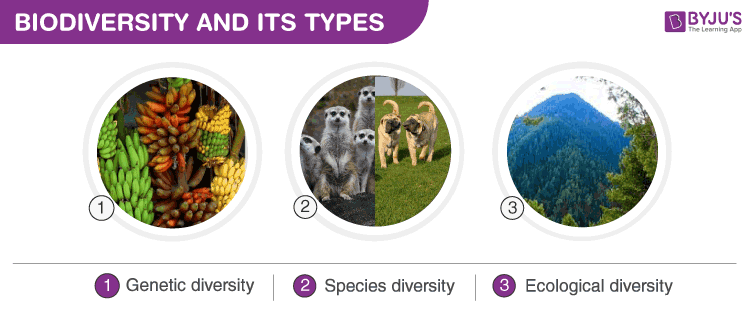Biodiversity Definition
“Biodiversity is the variation among living organisms from different sources including terrestrial, marine and desert ecosystems, and the ecological complexes of which they are a part.”
What is Biodiversity?
Biodiversity describes the richness and variety of life on earth. It is the most complex and important feature of our planet. Without biodiversity, life would not sustain.
The term biodiversity was coined in 1985. It is important in natural as well as artificial ecosystems. It deals with nature’s variety, the biosphere. It refers to variabilities among plants, animals and microorganism species.
Biodiversity includes the number of different organisms and their relative frequencies in an ecosystem. It also reflects the organization of organisms at different levels.
Biodiversity holds ecological and economic significance. It provides us with nourishment, housing, fuel, clothing and several other resources. It also extracts monetary benefits through tourism. Therefore, it is very important to have a good knowledge of biodiversity for a sustainable livelihood.
Also Read: Flagship Species
Types of Biodiversity
There are the following three different types of biodiversity:
- Genetic Biodiversity
- Species Biodiversity
- Ecological Biodiversity

Types of Biodiversity
Species diversity
Species diversity refers to the variety of different types of species found in a particular area. It is the biodiversity at the most basic level. It includes all the species ranging from plants to different microorganisms.
No two individuals of the same species are exactly similar. For example, humans show a lot of diversity among themselves.
Genetic diversity
It refers to the variations among the genetic resources of the organisms. Every individual of a particular species differs from each other in their genetic constitution. That is why every human looks different from each other. Similarly, there are different varieties in the same species of rice, wheat, maize, barley, etc.
Ecological diversity
An ecosystem is a collection of living and non-living organisms and their interaction with each other. Ecological biodiversity refers to the variations in the plant and animal species living together and connected by food chains and food webs.
It is the diversity observed among the different ecosystems in a region. Diversity in different ecosystems like deserts, rainforests, mangroves, etc., include ecological diversity.
Also Read: Biodiversity in Plants and Animals
Importance Of Biodiversity
Biodiversity and its maintenance are very important for sustaining life on earth. A few of the reasons explaining the importance of biodiversity are:
Ecological Stability
Every species has a specific role in an ecosystem. They capture and store energy and also produce and decompose organic matter. The ecosystem supports the services without which humans cannot survive. A diverse ecosystem is more productive and can withstand environmental stress.
Economic Importance
Biodiversity is a reservoir of resources for the manufacture of food, cosmetic products and pharmaceuticals.
Crops livestock, fishery, and forests are a rich source of food.
Wild plants such as Cinchona and Foxglove plant are used for medicinal purposes.
Wood, fibres, perfumes, lubricants, rubber, resins, poison and cork are all derived from different plant species.
The national parks and sanctuaries are a source of tourism. They are a source of beauty and joy for many people.
Ethical Importance
All the species have a right to exist. Humans should not cause their voluntary extinction. Biodiversity preserves different cultures and spiritual heritage. Therefore, it is very important to conserve biodiversity.
Biodiversity in India
India is one of the most diverse nations in the world. It ranks ninth in terms of plant species richness. Two of the world’s 25 biodiversity hotspots are found in India. It is the origin of important crop species such as pigeon pea, eggplant, cucumber, cotton and sesame. India is also a centre of various domesticated species such as millets, cereals, legumes, vegetables, medicinal and aromatic crops, etc.
India is equally diverse in its faunal wealth. There are about 91000 animal species found here.
However, diversity is depleting at a drastic rate and various programmes on biodiversity conservation are being launched to conserve nature.
Also read: Ecology
To know more about what is biodiversity, its definition, types and importance of biodiversity, keep visiting BYJU’S or download the BYJU’S app for further reference.
Explore more:
- How do mutations cause evolution?
- How are species and populations related?
- How many types of environment are there?
- Why was Charles Darwin’s theory important?
- Why should we conserve biodiversity short answer?
- What are the six different major levels of organization?



It is a good app because we learn more things from this app
It is very nice explanations
It’s good explanations and experience to me
Best app among all apps
Importance about environmental studies